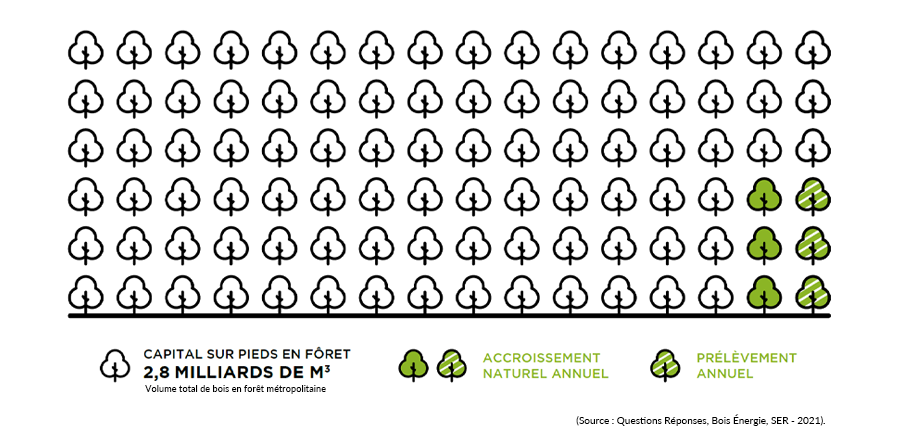Wood heating protects your future
To protect your future, you can always count on wood heating.

Choosing wood energy means reducing our dependence on fossil fuels, reducing CO2 emissions, and promoting the energy transition. Using wood energy is not deforestation, it is enhancing forest by-products, encouraging sustainable forest management, contributing to their maintenance, and enabling their regeneration. This is why wood energy is an energy of the present... and the future.
- Wood, a renewable energy source from French forests
- Wood energy is a resource available throughout the country - this is one of the major advantages of this renewable energy - which makes it possible to limit the importation of fossil fuels such as gas or fuel oil (according to France Bois Forêt, 90% of the wood energy used in France is French origin).
Another advantage is that there is no need to cut down trees to produce wood energy. Wood energy make it possible to recycle sawmill off-cuts, pruning wood, forest residues, and small-sized wood, that cannot be used in timber (construction, building, etc.) and industrial wood (papermaker, panel manufacturers, chemical manufacturers).
In France, wood harvesting is strictly controlled and does not exceed the natural regeneration capacity of the forests. This maintenance of the balance between tree cutting and regrowth ensures the sustainability of the resource. Here is the representation of the forest resource in France and the share taken annually:

- More renewable energy = less fossil fuels
- For some uses – this is the case with heating - and to some extent, it is possible to replace fossil fuels with wood energy. From an environmental point of view, there are several advantages:
- Wood energy is by definition a low-carbon energy (the CO2 released during combustion is offset by the CO2 captured by the trees during their growth) and less polluting than fossil fuels.
- By substitution effect, each kWh produced with wood energy replaces a kWh produced with gas, coal or fuel oil, avoiding the fossil greenhouse gas emissions.
- Upstream of end use, and even if they involve the use of fossil fuels and therefore fossil carbon emissions, the environmental costs of producing, processing and transporting wood energy are significantly lower than those of producing, processing and transporting fossil fuels.
- « The raw material remains within the regional perimeter of the place of production, often at distances of less than 100 km, unlike fossil fuels which, for the most part, come from distant countries. »
- (Source : Questions Réponses, Bois Énergie, SER - 2021)
- If the number of wood heating appliances increases, will fuel consumption also increase?
In France, nearly 8 million homes are currently equipped with a wood-burning heater, and 10 million are expected to do so by 2035*. It might be logical to assume that this increase in the number of appliances will put more pressure on French forests. But no.
No, because the players in the wood heating sector keep innovating to offer solutions that are always more efficient, cleaner, and less energy-consuming.
No, because with the predictable modernization of the appliance fleet in the coming years (this includes the replacement of older, less efficient appliances and the "net" creation of new wood heating installations), with the use of high-performance fuel and the installation of quality flues, it is estimated that by 2035, log wood consumption will be reduced by 30%.
In other words, we will consume less wood for the same, or even better, thermal comfort. Here is a projection of the evolution of log wood consumption and the number of log wood appliances by 2035.

- *Source: CÉRIC Laboratory, study “Perspective for the domestic wood-burning appliance fleet” (Sept. 2024)
- Wood energy, one of the drivers of the energy transition
The first renewable energy used in France, we must no longer consider wood energy as just a source of heating: wood energy is a pillar of the energy transition! One last example to convince you? The building.
Popular with consumers, wood heating is also appreciated in the construction sector because it helps meet the decarbonization challenges set for buildings.
Low in CO2 emissions and benefiting from a good substitution factor compared to fossil fuels, wood heating is classified among the most virtuous heating methods according to the indicators of the RE2020 environmental regulations.
In short, this is an energy that offers many perspectives.











